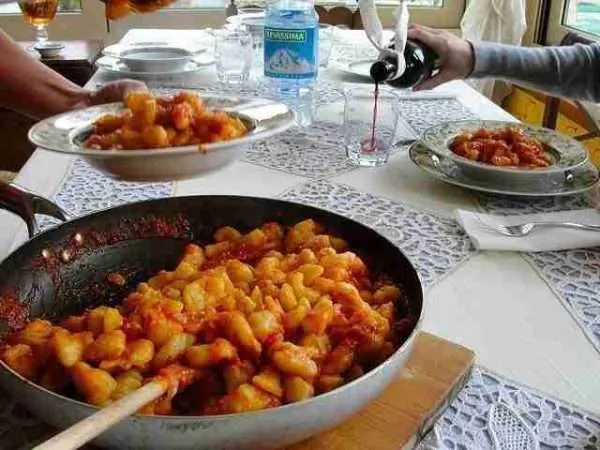
Pity the poor American who can only find comfort in the familiar flavors and food textures of home. Pity me for not taking kindly to the coniglio (rabbit) or swooning at the sight of chicken liver crostini or the tripe truck in Florence. It’s not that I don’t have an adventurous palate. I’ve happily chewed on chunks of guanciale (boar’s cheek), the fatty meat that gives bucatini all’amatriciana its savory lusciousness, and I’ve even snacked on lumache (snails), all garlicky and buttery and served with a hunk of bread to sop up the juices.
When I travel, I try to have an open mind when it comes to trying new foods. But meats have never really been my thing. I’m more interested in seeing what different cultures do with their vegetables — how they saute them, roast them, steam them, sauce them, dice and shred them for salads, or bake them in casseroles.
The world is keenly aware of what the Italians did with the tomato, a vegetable (or fruit, if you’re being technical) that didn’t even arrive in Europe until the 1500s but is now the cornerstone of dozens of dishes found in every region of Italy. Making its arrival in Italy at the same time as the tomato was the potato, which, like the tomato and other edible products from the New World, “stimulated the native genius [of Italy] by giving it new materials to work with.” (See Waverley Root’s The Food of Italy.)
The potato is a vegetable that no one really associates with Italy but that features in two dishes that either make me feel at home when I’m Italy or give me a fit of nostalgia if I try them here stateside. In this month’s Italy Blogging Roundtable, we look at comfort foods in the context of Italy. Here are two of mine.
On the “fast food” end of things is pizza di patate, a snack that is loaded with as many memories as it is carbs. I was living in Rome as an au pair when I first came across potato pizza. It was served in almost every “pizza al taglio” (pizza by the slice) joints and was particularly ubiquitous near universities. Another name for pizza di patate is “pizza lo studente” or “the student’s pizza,” a cheap, filling meal for anyone whose hunger outweighed the bills in his wallet.
While I wasn’t a student at the time, I was on a student’s budget and pizza lo studente became a lunchtime staple. For just a couple of lire (yes, this was long ago), I could get the pizzaiuolo to heat up a hefty square of pizza di patate, fold it so the ingredient ends touched and stayed hot, and wrap it up tightly in waxed paper. The portable treat was filling – a gut buster, if I wasn’t careful – but it also struck me as a somewhat sophisticated pizza choice, not swimming in sauce or dotted with vegetables, but topped with thin slices of al dente potatoes dressed in rosemary, salt, and a bit of cheese.
I’m nostalgic, or comforted, by the thought of pizza lo studente because it reminds me of a time when I was finding my way — professionally, personally, and gastronomically. A bite of that pizza will always bring me back to thoughts of wandering the streets of Rome, heavy with my thoughts and full in my belly.
If you’d like to learn more about pizza di patate, Ciao Chow Linda has a lovely write-up and recipe.

My other Italian potato dish obsession is gnocchi. Gnocchi are typically made from potatoes, though there are semolina and vegetable variations that are similarly shaped like nocche or knuckles. Occupying the space between pasta, polenta, and ravioli, gnocchi are Italy’s densest of dumplings, capable of absorbing the full flavor of a heavy ragú while retaining their own uniquely pillowy texture.
They are a curious invention, elevating the lowly potato into something sublime. To say that I can exactly pinpoint the moment that I first had gnocchi would be a lie. I can’t. But I also can’t recall the first time I ate spaghetti. Or lasagne. Gnocchi have that melt-in-your-mouth quality, much like Thanksgiving mash potatoes and gravy do, that transmits a signal between palate and brain that you are home.
Each time I go to Italy, specifically to Rome, I try to indulge my cravings for gnocchi, especially on Thursdays. Giovedì tends to be the day that most restaurants in Rome feature a gnocchi dish, whether al ragú, with ricotta, or even all’amatriciana a dish that food blogger Katie Parla found was particularly perfect at L’Arcangelo. When I can’t get to Rome, you’ll find me poring over a pristine, yet much-used “Rome Issue” of Gourmet from 2005, which has a wonderful gnocchi di patate recipe if you can get your hands on it. If you can’t, take a look at Lidia Bastianich’s gnocchi recipe on Epicurious.com.
The title of this post is a play-on-words of the former Gourmet Editor-in-Chief Ruth Reichl’s memoirs Comfort Me With Apples which is derived from this biblical quote:
Comfort me with apples, for I am sick of love.
The expression is intended to mean that apples, a symbol of love, are to act as a stand-in to soothe one’s lovesickness and longing for heaven. As Reichl knows all too well, food in general, when eaten in moderation and with respect, has the power to comfort us and to fill-in memories where the synapses fail us. With one bite of pizza di patate or gnocchi, I am immediately transported to my potato days in Rome. And, as long as I have my taste buds, I can always find my way back to my long lost Italian home.
Read the posts, leave comments, share them with your friends – and tune in next month for another Italy Blogging Roundtable topic.
- ArtTrav – Minestrone: my winter comfort food
- At Home in Tuscany – Tuscan Comfort Food
- Brigolante – Eating in the Comfort Zone
- WhyGo Italy – Comfort Food is a Cultural Thing
Post first published on November 9, 2011








